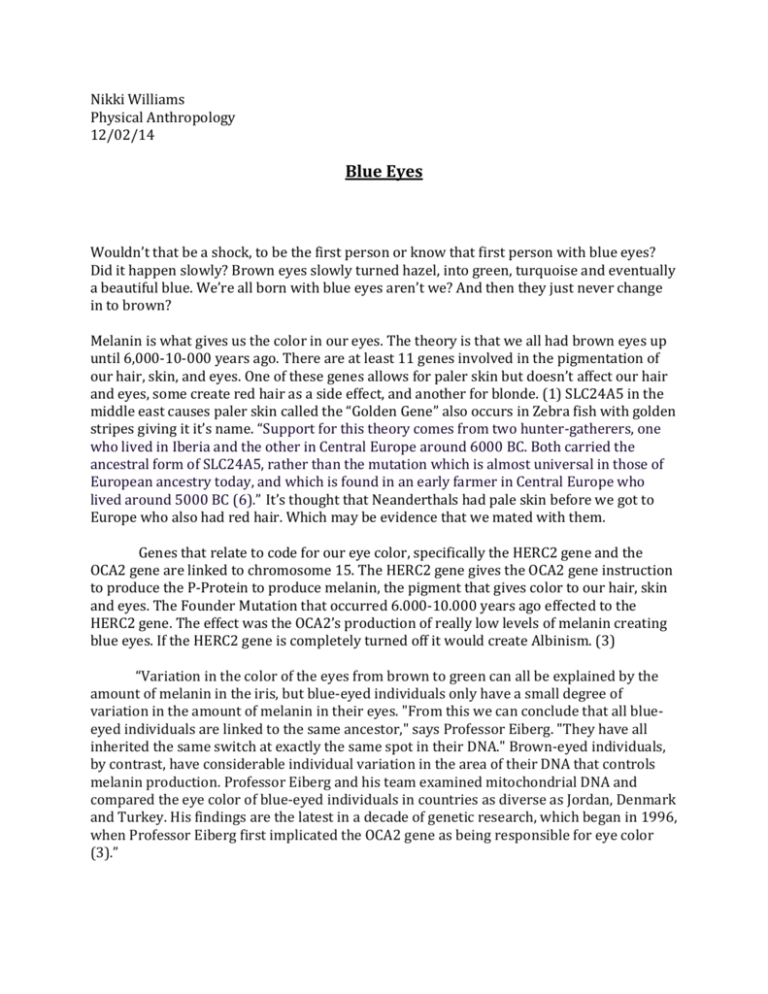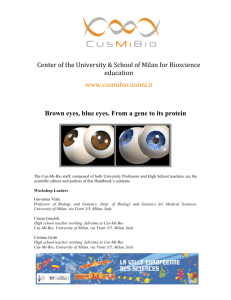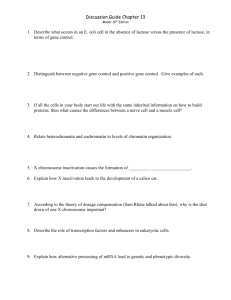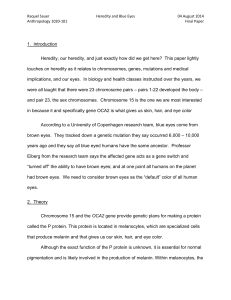essay
advertisement

Nikki Williams Physical Anthropology 12/02/14 Blue Eyes Wouldn’t that be a shock, to be the first person or know that first person with blue eyes? Did it happen slowly? Brown eyes slowly turned hazel, into green, turquoise and eventually a beautiful blue. We’re all born with blue eyes aren’t we? And then they just never change in to brown? Melanin is what gives us the color in our eyes. The theory is that we all had brown eyes up until 6,000-10-000 years ago. There are at least 11 genes involved in the pigmentation of our hair, skin, and eyes. One of these genes allows for paler skin but doesn’t affect our hair and eyes, some create red hair as a side effect, and another for blonde. (1) SLC24A5 in the middle east causes paler skin called the “Golden Gene” also occurs in Zebra fish with golden stripes giving it it’s name. “Support for this theory comes from two hunter-gatherers, one who lived in Iberia and the other in Central Europe around 6000 BC. Both carried the ancestral form of SLC24A5, rather than the mutation which is almost universal in those of European ancestry today, and which is found in an early farmer in Central Europe who lived around 5000 BC (6).” It’s thought that Neanderthals had pale skin before we got to Europe who also had red hair. Which may be evidence that we mated with them. Genes that relate to code for our eye color, specifically the HERC2 gene and the OCA2 gene are linked to chromosome 15. The HERC2 gene gives the OCA2 gene instruction to produce the P-Protein to produce melanin, the pigment that gives color to our hair, skin and eyes. The Founder Mutation that occurred 6.000-10.000 years ago effected to the HERC2 gene. The effect was the OCA2’s production of really low levels of melanin creating blue eyes. If the HERC2 gene is completely turned off it would create Albinism. (3) “Variation in the color of the eyes from brown to green can all be explained by the amount of melanin in the iris, but blue-eyed individuals only have a small degree of variation in the amount of melanin in their eyes. "From this we can conclude that all blueeyed individuals are linked to the same ancestor," says Professor Eiberg. "They have all inherited the same switch at exactly the same spot in their DNA." Brown-eyed individuals, by contrast, have considerable individual variation in the area of their DNA that controls melanin production. Professor Eiberg and his team examined mitochondrial DNA and compared the eye color of blue-eyed individuals in countries as diverse as Jordan, Denmark and Turkey. His findings are the latest in a decade of genetic research, which began in 1996, when Professor Eiberg first implicated the OCA2 gene as being responsible for eye color (3).” Around this time modern Homo Sapiens learned that they could manipulate plants and would select the best to grow and perfect it slowly. This transitional time would have been hard especially if their other original resources (meat) were running out. With new agriculture and a small variety of plants, they wouldn’t be able to receive enough nutrition to sustain a healthy body. Low vitamin D levels would lower mineral absorption as well as lower the immune system that would allow for Rickets and would create a degeneration of their bones, bending and fracturing under their body weight, from being to soft. If the mutation happened it Africa, lighter skin would have been disadvantageous and would allow too much UV radiation causing skin cancer. And Dark skin would be disadvantageous in Europe because they wouldn’t be able to absorb enough vitamin D. Though it could have been a great reason to leave Africa in search for better living conditions. Their skin at this time still consisted of only darker shades, which would have been fine to live with had they stuck with a better more nutritious diet. The lightest of those shades would have a selective advantage to absorbing more UV light and vitamin D than the other Dark Skin people around them and in turn would have a greater fitness for a reproductive advantage. Less and less melanin was produced continuing until dark skin faded away as light skin was more adaptive to the darker, colder climate. The mutation that happened to our skin is what effected our eye color. (6) Another theory is that it was a better trait for sexual selection. That mutation itself was more attractive and those with the “old” look phased out, Or, “The mutation of brown eyes to blue represents neither a positive nor a negative mutation. It is one of several mutations such as hair color, baldness, freckles and beauty spots, which neither increases nor reduces a human's chance of survival. As Professor Eiberg says, "it simply shows that nature is constantly shuffling the human genome, creating a genetic cocktail of human chromosomes and trying out different changes as it does so (Hans Eiberg)."(3) Well, A Migration of people to Europe in the black sea area happened 16000-35000 y.a.. For resources, from an over population of where they once existed. They hunted and gathered when they arrived and for a while after. They adapted to their environment genetically for better traits that would allow for better health. As they settled and figured agriculture out allowing them to also have the health to reproduce their population grew and became too crowded. Consequently farmers spread their population in different directions taking their mutation for light characteristics with them. Eventually running into other people that had migrated to different areas of the world that were also migrating for resources and space thus mating with people with different characteristics- i.e. brown eyes and darker skin. There could be an advantage of blue eyes. Less melanin in the skin allows for absorption of UV rays to allow for absorption of necessary minerals and nutrients. In a darker climate with winters with less daylight it would be advantageous to have lower melanin in the eyes to allow the eyes to absorb as much light as possible to prevent (SAD) Seasonal Affective Disorder. No matter. The spread of the mutation has had great selection and is still present today.(7) Blue Eyed Europeans are thought to have mated with each other creating a concentration of people with the same gene for blue eyes, lighter eyes and skin. They stayed as sedentary people for a long while until eventually they became over populated and split of and mated with brown-eyed people. They moved to find more open un-inhibited land for agricultural use, eventually coming upon other people. (7) The spread of blue eyes is worldwide. The Gene for blue eyes is recessive and if only one parent has the gene, it wont be passed on. This can happen and slowly phase out the gene. Though if it is passed through the mother the gene is passed through mitochondrial DNA and will stay hidden until it is paired with a male’s gene for blue eyes. Blue eyes may not be selected for now because different cultures migrate all over the world. Too much light can have a degenerative effect as well. Also through cultures from all over the world coming together these populations aren’t as concentrated and blue eyes are becoming less and less common. (1) F. Liu et al., Digital quantification of human eye color highlights genetic association of three new loci, PLoS Genetics, vol. 6, no. 5 (2010), e1000934; J. Mengel-From et al., Genetic determinants of hair and eye colour in the Scottish and Danish populations, BMC Genetics vol. 10 (December 2009) 88; R.A. Sturm, Molecular genetics of human pigmentation diversity, Human Molecular Genetics, vol. 15, no. 18(R1) (April 2009), R9-17; W. Branicki, Interactions between HERC2, OCA2 and MC1R may influence human pigmentation phenotype, Annals Human Genetics, vol. 73, no. 2 (Mar 2009), pp.160-70. (3) University of Copenhagen. "Blue-eyed humans have a single, common ancestor." ScienceDaily. ScienceDaily, 31 January 2008. <www.sciencedaily.com/releases/2008/01/080130170343.htm>. Source: Eiberg, Hans. "Blue Eye Color in Humans May Be Caused by a Perfectly Associated Founder Mutation in a Regulatory Element Located within the HERC2 Gene Inhibiting OCA2 Expression - Springer." Blue Eye Color in Humans May Be Caused by a Perfectly Associated Founder Mutation in a Regulatory Element Located within the HERC2 Gene Inhibiting OCA2 Expression - Springer. SpringerVerlag, 3 Jan. 2008. Web. 4 Dec. 2014. <http://link.springer.com/article/10.1007/s00439007-0460-x/fulltext.html>. (5) G.E. Adán et al., Fish as diet resource in North Spain during the Upper Paleolithic, Journal of Archaeological Science, vol. 36, no. 3 (March 2009), pp. 895-899. (6) Manco, Jean. "Ancestral Journeys." Who Do You Look Like? 29 Nov. 2010. Web. 4 Dec. 2014. <http://www.ancestraljourneys.org/looks.shtml>. (7) S. Higuchi et al., Influence of eye colors of Caucasians and Asians on suppression of melatonin secretion by light, American Journal of Physiology - Regulatory, Integrative and Comparative Physiology, vol. 292, no. 6 (June 2007), pp. R2352-R2356.








